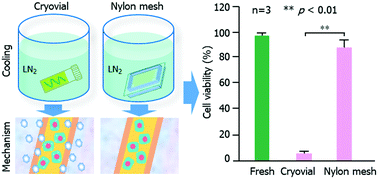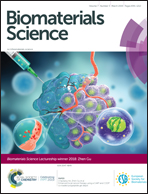Vitrification of stem cell-laden core–shell microfibers with unusually low concentrations of cryoprotective agents†
Abstract
Cell-laden alginate hydrogel microfibers are particularly useful for building and repairing complex tissues because they are long, thin, and flexible. Therefore, they have important application value in regenerative medicine and clinical treatments. Cryopreservation is indispensable in order to ensure their “off-the-shelf” ready availability. Ice-free vitrification is considered an ideal method to preserve stem cell constructs (from cells to the overall ultrastructure of hydrogel). However, the vitrification process for preserving cell constructs requires highly toxic and cell membrane permeable cryoprotective agents (pCPA) and even requires the assistance of complex physical field based space warming technology. Therefore, a simple and feasible method is urgently needed. In addition, there are no reports about microfiber vitrification, as reports are limited to microcapsules. In this study, a novel device with nylon mesh for vitreous cryopreservation of hydrogel microfibers is developed to achieve ultra-rapid heat transfer by effectively suppressing film boiling during cooling. This may provide a low-toxic and cost-effective method for vitrification of cell-laden hydrogel microfibers with ultra-low concentrations of pCPA, facilitating their application in regenerative medicine.



 Please wait while we load your content...
Please wait while we load your content...